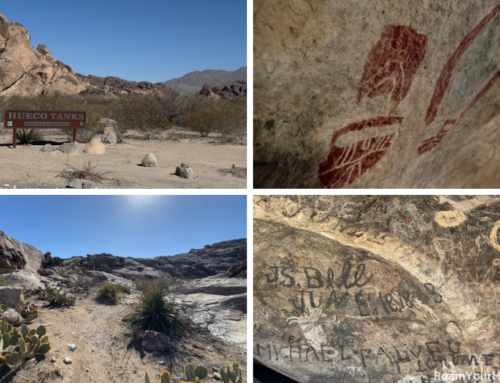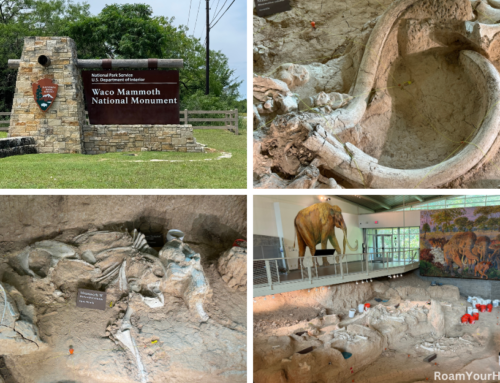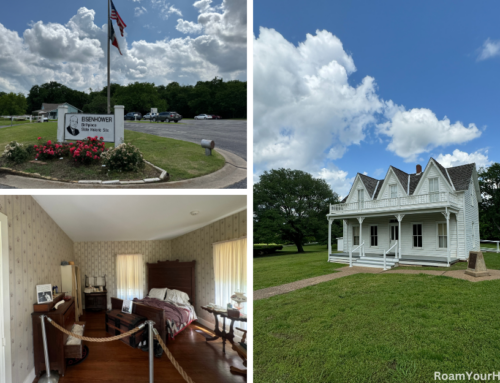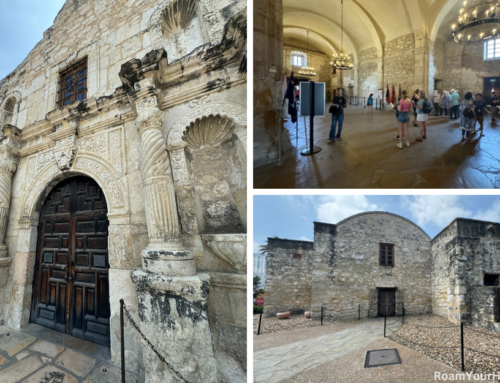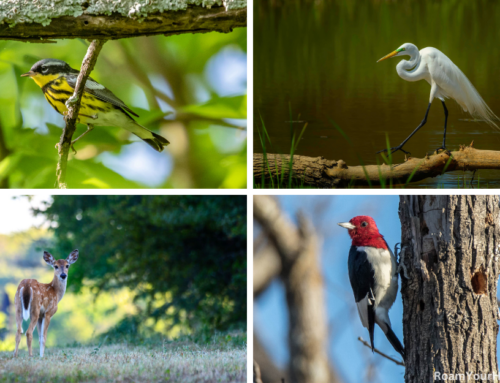
Visitors Guide for the Lyndon B. Johnson National Historic Site
The Lyndon B. Johnson National Historic Site celebrates the storied life of the 36th President of the United States. It’s in the middle of the Texas Hill Country, an easy drive north of San Antonio and west of Austin.
The Lyndon B. Johnson National Historic Site preserves important locations related to President Johnson’s life, from his humble beginnings to his time in the White House. Established in 1969, the site includes the LBJ Boyhood Home, the Johnson Settlement, and the LBJ Ranch, often called the “Texas White House.” Johnson spent much of his life in this region, shaping his deep connection to rural America and the policies that defined his presidency.
We visited on a hot spring afternoon. We were nearing the end of a road trip exploring Texas. Pulling into the visitor center, my wife and I were excited. We are a bit of presidential history nerds, and visiting LBJ’s site was entirely new for us.
Things to See and Do at the Lyndon B. Johnson National Historic Site
Visitor Center in Johnson City
Our first stop was the Visitor Center in Johnson City. Here, we watched a short film about LBJ’s life and presidency. There were a bunch of fascinating exhibits showcasing his early years and political career. An exhibit also features a tribute to Mrs. “Lady Bird” Johnson.

LBJ Boyhood Home
After the visitor center, we took a short walk to LBJ’s Boyhood Home. The well-preserved houses where young Lyndon grew up. Guided tours provide insights into his upbringing, family life, and early influences that shaped his leadership style.
Lyndon Johnson’s family moved into a three-bedroom, white-frame home in Johnson City in September 1913, just two weeks after Lyndon’s fifth birthday. For most of the next twenty-four years, this was their home.
LBJ’s more than 3 decades career in public service began on the porch of the home when he announced a run for for congress in 1937.
During the home tour, you get a feel for what it was like for Johnson growing up there with his parents and four siblings. You see the girl’s room, where Lyndon’s three sisters shared this bedroom
We learned about Johnson’s father, who served as a state legislator for over a decade. From his father, is where Lyndon’s love of politics began. “I loved going with my father to the legislature,” remembered President Johnson. “The only thing I loved more was going with him the trail during his campaigns. For re-election. We drove the Model T Ford from farm to farm … stopping at every door.” There is a Model T similar to the one he rode in the visitor center.
In the kitchen, you see the family’s stove where his mother often made a favorite of his, chili. You also see the would-be president’s bedroom and his parent’s room. The tour is well put together and worth your time.
Johnson Settlement
After checking out the boyhood home, we made our way to the historic Johnson Settlement, which you can get to by walking a short nature trail from the Visitor Center. It’s less than a mile round trip.
The Johnson Settlement, a preserved 19th-century homestead once owned by LBJ’s grandfather and great-uncle, who established a cattle droving headquarters in the 1860s. A trail goes by their log cabin, barns, cooler house, and windmill, which still stand.
If you are traveling west on Highway 290 from Johnson City towards the LBJ Ranch, there is also a marked pullout where you can park and walk into the settlement.
The Johnson Settlement offers a look at frontier life in Texas.

LBJ Ranch and the Texas White House
“All the World is Welcome Here” – LBJ
Next, we hopped in our car and headed 14 miles west of Johnson City in Stonewall to the LBJ Ranch.
Our first stop was the LBJ State Park and Historic Site, which is adjacent to the NPS site, just across the Pedernales River. We briefly stopped by the visitor center before going down the park road. You have to get a free driving permit at the visitor center to take the self guided driving tour in the park.
After that, we first headed towards the living history farm, which was strongly recommended by the ranger in the V.C.
Sauer-Beckmann Living History Farm
This Sauer-Beckmann Living History Farm is a working farm near the ranch that offers a hands-on experience of early 1900s rural life. It’s located in the LBJ State Park.
It was cool to check out during our visit. Costumed interpreters demonstrated traditional farming techniques, including blacksmithing, cooking, and livestock care. We arrived in the late afternoon, so they were winding down for the day, but it was still a fun experience. This would be an excellent stop for families with young children. A bonus for us, we saw a couple of dozen white-tailed deer on the short drive to the farm from the State Park Visitor Center.
Visiting Lyndon B. Johnson National Historic Site
Next, we crossed the Pedernales River and entered the LBJ National Historic Site, where we would drive the road and take a self-guided tour.
Junction School: LBJ’s One-room School
Our first stop was the Junction School. It was in this one-room school that Lyndon Johnson began his education in 1912 when he was 4 years old. Johnson was the youngest student in the glass then, often sitting on the teacher’s lap during reading lessons.
“I first remember walking along the banks of the Pedernales when I was a boy four or five years of age.” – Lyndon B. Johnson
The Reconstructed Birthplace Home
We passed the park entrance sign on the way to our next stop, the “Reconstructed Birthplace.” We parked our car and started walking towards the home. It was near this site at dawn on August 27th, 1908, that the future 36th President of the United States was born. Lyndon Baine Johnson lived here for the first five years of his life.
In 1964, the President and Mrs. Johnson had the home built as a guest house for visitors to the LBJ Ranch. It stands on the site and closely resembles the original home, which was removed in the 1930s. It was never intended as a literal reconstruction; “the birthplace” was furnished with Johnson family mementos spanning generations.
The birthplace cottage is the nation’s only presidential birthplace to be reconstructed, refurnished, and interpreted by an incumbent chief executive.
“Here is where I would always return, to the Pedernales River, the scenes of my childhood.” – Lyndon B. Johnson

President Lyndon B. Johnson’s Grave
The Johson Family Cemetery was our next stop. President Lyndon B. Johnson and his wife, Lady Bird Johnson, are buried here. The cemetery is private, and you are not permitted to access it. However, you can see LBJ and Lady’s Grave from the walls.
President John and Mrs. Johnson’s gravestones are the tallest red granite markers in the main row. His family are on each side of them.
“Here amidst these familiar hills and under these expansive skies and under these beautiful oak trees that he loved so much, his earth life has come full circle … his roots were deep, right here in this spot in the hill country.” – Reverend Billy Graham’s Eulogy of LBJ January 25, 1973
Sam E. Johnson Sr. House
The Sam E. Johnson Sr. House is where LBJ’s grandparents lived. Even as an adult, he would never forget the connection he felt toward his paternal grandparents. Sam and Eliza Johnson lived in the home until they died in 1915 and 1917, respectively. Both are buried in the family cemetery.
Next on our drive, we passed the Cedar Guest House, which was used by guests to the LBJ Ranch. Perhaps most notably, the house was the site of an interview between Walter Cronkite and LBJ shortly before his death in January 1973.
Next, we took a right by a field following the road. Here, we were treated to a wildflower-saturated pasture. Hundreds of thousands of Indian Blanket wildflowers bursting with vibrant color dotted the field. The view was nothing short of stunning.
The view really put an exclamation point on Johnson’s legacy as the “Environment President.” During his administration, he signed nearly 300 conservation measures into law, forming the basis of the modern environmental movement. Wilderness areas and almost 50 new national park sites were created, and existing ones were expanded. Something every park lover like myself should be thankful towards LBJ for to this day.
Show Barn
We passed the Show Barn next. The LBJ Ranch is still a working ranch. Driving the road, we got a close-up view of Herford cattle. They were LBJ’s breed of choice. Descendants of the president’s cattle were still roaming the ranch during our visit and will be during yours.
Johnson kept two herds of cattle and one commercial herd to be sold for beef. The other was a 500-head herd to be sold for breeding purposes. The show barn was the center of all ranching operations.
The Texas White House
Next up, the LBJ Ranch House. Unfortunately, it was closed for renovations during our visit, so we did not get to go inside. However, we could still see the house from the outside and explore the grounds.
Johnson conducted much of his presidency from his ranch home. President Johnson was the first to create a functioning White House away from Washington. Leaders worldwide visited the Johnsons, and during the Administration, it became known as the Texas White House. Mrs. Johnson lived at the Ranch part-time until she died in 2007.
It may have been known to the world as “The Texas White House,” but for the Johnson family, it was known as “Our Heart’s Home.”
The home was a part of Johnson as president and as a child. Here he made some of his favorite memories both as a boy and the leader of the free world: “I first came to this house as a very young boy. … Frequently, I would come here during the summer when Judge Martin, my uncle, lived here, and I’d spend three months’ vacation from school riding with him and looking after the cattle. I kept coming back to this house. I guess I must have had a yearning to someday own it. But when we came here on one of the periodic visits in 1952, my aunt told me that she was in advancing years and poor health and she wondered if I wouldn’t buy the place. And I did.”
Lawn Chair Staff Meetings
He loved having his cabinet visit. He would hold “Lawn Chair Staff Meetings” Mrs. Johnson would recall: “It was always Lyndon’s favorite time, particularly around sunset, from the earliest spring until cold weather drove us in. And we have lots of interesting pictures in this front yard. I remember Adlai Stevenson, and the Speaker, Mr. Rayburn and Lyndon. And indeed, I remember President Truman’s visit. I think he was here at least twice. Once was for the barbecue that we had for President Lopez-Mateos of Mexico down there in the grove on the river.”
We were disappointed we did not get to visit the home, but that was okay in the end. It’s just an excuse to visit again later. We were very happy we visited that time as well. It was a wonderful experience to learn more about and walk in the footsteps of one of the most transformative leaders in U.S. history.
Tips for Visiting the Lyndon B. Johnson National Historic Site
Hours & Fees: The site is open daily, but hours vary by location. Entry to most areas is free, though donations are encouraged.
Tours and Talks: Ranger-led tours may be available for some locations, providing deeper insights into LBJ’s life and legacy.
Best Time to Visit: Spring and fall offer pleasant weather for exploring the outdoor areas. As I mentioned earlier, I cannot recommend Spring enough. The wildflowers are simply incredible.

